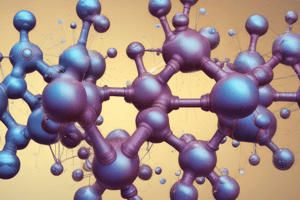Podcast
Questions and Answers
Which of the following is NOT a property of acids?
Which of the following is NOT a property of acids?
- Sour taste
- Slippery feel (correct)
- Turn blue litmus paper red
- Conduct electricity in solution
What is the general equation for a neutralization reaction?
What is the general equation for a neutralization reaction?
- Acid + Salt → Base + Water
- Salt + Water → Acid + Base
- Base + Water → Acid + Salt
- Acid + Base → Salt + Water (correct)
Which of the following is NOT a common use of acids?
Which of the following is NOT a common use of acids?
- Food preservation
- Cleaning agents
- Battery production
- Soap making (correct)
What is the pH range for acidic solutions?
What is the pH range for acidic solutions?
Which of the following is an example of a base?
Which of the following is an example of a base?
Which of the following is a property of salts?
Which of the following is a property of salts?
What does the pH scale indicate?
What does the pH scale indicate?
Which of the following is NOT an example of a salt?
Which of the following is NOT an example of a salt?
Flashcards are hidden until you start studying
Study Notes
Acids
- Definition: Substances that donate protons (H⁺ ions) in a chemical reaction.
- Properties:
- Sour taste
- Conduct electricity in solution
- Turn blue litmus paper red
- React with metals to produce hydrogen gas
- Examples:
- Hydrochloric acid (HCl)
- Sulfuric acid (H₂SO₄)
- Acetic acid (CH₃COOH)
Bases
- Definition: Substances that accept protons or donate hydroxide ions (OH⁻) in a reaction.
- Properties:
- Bitter taste
- Slippery feel
- Conduct electricity in solution
- Turn red litmus paper blue
- Examples:
- Sodium hydroxide (NaOH)
- Potassium hydroxide (KOH)
- Calcium carbonate (CaCO₃)
Salts
- Definition: Ionic compounds formed from the neutralization reaction between an acid and a base.
- Properties:
- Usually crystalline at room temperature
- High melting and boiling points
- Can conduct electricity when dissolved in water
- Examples:
- Sodium chloride (NaCl) - common table salt
- Calcium sulfate (CaSO₄)
- Ammonium nitrate (NH₄NO₃)
pH Scale
- Range: 0 to 14
- Acidic: pH < 7
- Neutral: pH = 7 (pure water)
- Basic: pH > 7
- Significance: Indicates the concentration of H⁺ ions in a solution; lower pH means higher acidity, higher pH means higher alkalinity.
Neutralization Reaction
- Definition: A chemical reaction between an acid and a base producing salt and water.
- General Equation:
- Acid + Base → Salt + Water
- Importance: Used in various applications, including antacid formulations and in treating acidic soils.
Common Uses
- Acids: Food preservation, battery production, cleaning agents.
- Bases: Cleaning products, antacids, soap making.
- Salts: Food seasoning, fertilizers, water softeners.
Acids
- Acids are substances that donate protons (H⁺ ions) during chemical reactions.
- Characteristic properties include a sour taste, the ability to conduct electricity in solution, turning blue litmus paper red, and reacting with metals to release hydrogen gas.
- Notable examples include hydrochloric acid (HCl), sulfuric acid (H₂SO₄), and acetic acid (CH₃COOH).
Bases
- Bases are substances that either accept protons or donate hydroxide ions (OH⁻) in reactions.
- They are identified by their bitter taste, slippery texture, ability to conduct electricity in solution, and their capacity to turn red litmus paper blue.
- Common bases include sodium hydroxide (NaOH), potassium hydroxide (KOH), and calcium carbonate (CaCO₃).
Salts
- Salts are ionic compounds produced through the neutralization of an acid and a base.
- They typically form crystalline structures at room temperature, possess high melting and boiling points, and can conduct electricity when dissolved in water.
- Examples of salts are sodium chloride (NaCl), calcium sulfate (CaSO₄), and ammonium nitrate (NH₄NO₃).
pH Scale
- The pH scale ranges from 0 to 14, measuring the acidity or alkalinity of a solution.
- Solutions with a pH less than 7 are classified as acidic, a pH of 7 indicates neutrality (like pure water), and a pH greater than 7 indicates basicity.
- The pH value reflects the concentration of H⁺ ions; lower pH indicates stronger acidity, while higher pH indicates stronger alkalinity.
Neutralization Reaction
- A neutralization reaction occurs when an acid reacts with a base to produce salt and water.
- The general equation for this reaction is: Acid + Base → Salt + Water.
- This type of reaction is vital in various applications such as antacid production and acidic soil treatment.
Common Uses
- Acids are commonly used in food preservation, battery production, and as cleaning agents.
- Bases find applications in cleaning products, antacids, and soap manufacturing.
- Salts are widely used for seasoning food, in fertilizers, and as water softeners.
Studying That Suits You
Use AI to generate personalized quizzes and flashcards to suit your learning preferences.




